Ancient Elongated Skulls and Cranial Deformation
Cranial Deformation
The recent discovery of the skull (right) from Sonora, Mexico has promoted a wave of articles proclaiming it, and other similar examples to be evidence of ancient alien contact. Images of elongated skulls or 'cone-heads' can be seen as far back as Sumerian and Egyptian times, but the act of cranial deformation can be traced as even further to 45,000 years ago (1), suggesting it's importance surpassed the safety of the child even then as cranial deformation is invariably carried out on infants while the bones are supple and flexible and can be fatal in cases of excessive deformation, which raises the important question: What was it that has led so many people from so many varied cultures to incorporate this characteristic into their children? 'Cranial deformation can be defined as the product of “dynamic distortion of the normal vectors of the infantile neurocranial growth through the agency of externally applied forces' (Moss, 1958; p 275). It has been found in every continent and is not limited to humans (Shapiro, 1927; Trinkaus, 1982; Gerszten and Gerszten, 1995; Tubbs, Salter, and Oaks, 2006). (5) As noted above, the cultural preference for elongated skulls has found its way onto every continent on the earth suggesting a cultural connection of great antiquity, and therefore one of potential importance. In the earliest Sumerian Al Ubiad pottery, there is a clear association to the gods, and variations on the idea that it was a symbol of status, high rank, or wisdom have been recorded in the traditions of differing cultures around the world offering a common theme that exists in the minds of people to this day. The pertinent question with regard this phenomena is whether or not such cranial deformity dolichocephaly has ever existed naturally in humans, and if so, what is the significance of such persistent emulation through artificial deformity by so many peoples for such a long time.
Cranial Deformation:
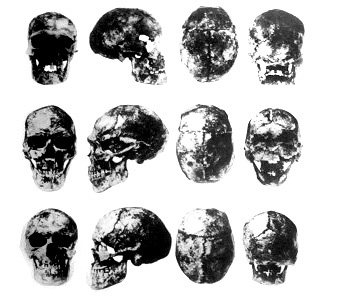
Examples of Dolicocephalic Czech Cranium 35,000 BC:
"14. I will pass over the smaller differences among the nations, but will now treat of such as are great either from nature, or custom; and, first, concerning the Macrocephali [tribe or `nation' said to be living beyond the Bosphorus / Black Sea or maybe even further i.e Scythians - RD] There is no other race of men which have heads in the least resembling theirs".
"...At first, usage was
the principal cause of the length of their head, but now nature cooperates
with usage. They think those the most noble who have the longest
heads...".
The act of artificial cranial deformation on infants was present in numerous ancient cultures, including some of the greatest, such as the Indus Valley, Sumerian, Egyptian, Olmec, Mayan, Inca etc etc... At present, such practices are all but gone but they were recorded into the 20th century with records of 'Some isolated groups in Africa and South America who continue this practice'. (3) Of particular interest are those peoples which have been recorded to show a 'natural' or genetically inherited tendency for elongated skulls, as it has been shown that the biological result of such deformation is a larger skull, but perhaps more significantly, a larger brain. Something which offers a clear incentive for such potentially dangerous practices on newborns, but also one which takes on a different light in consideration of the persistent veneration for elongated heads.
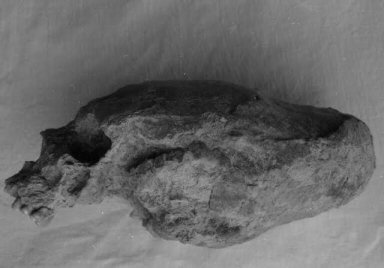 In the Old world, 'Huns' and 'Alans' are also known to have practised similar cranial deformation. At around AD 300-600, the East Germanic tribes who were ruled by the Huns, adopted this custom. 
The
Sumerians:
John Marshall’s “Mohenjo-Daro and the Indus Civilization” as well as “Anthropology” (by Ram Nath Sharma, Rajendra Kumar Sharma) in addition to Al-Ubaid burials, wrote that cranial deformation features were also seen of skulls of Kish; Ur of Mesopotamia; Additanallur in Madras; Veddahs of Ceylon (Sri Lanka); Naga of Calcutta; jar burials of Harappa; Mediterranean; Nal in Baluchistan; Sialkot in Punjab; and Bayana (Aryan skulls) in Uttar Pradesh. (2) Marshall (9) makes a comparison between the elongated Al Ubaid skulls and those found from the Indus Valley Civilisation, noting that the Al Ubaid skulls are 'Not as elongated as those from Mohenjo-Daro'. 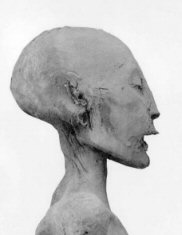 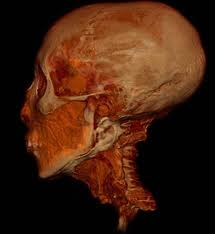
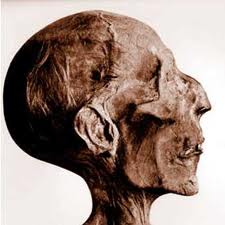
From left to right: The skulls of Nefertiti,
Tutankhamen, and Rameses II.
Whether or not this was a genetic trait or one enforced on the royal members at birth is unknown, but while the cranium appear extended at the rear, they do not show any evidence of artificial deformation. Perhaps relevant that In the 1st Century, Egyptian priest-scribes, then keepers of the world's oldest known records, claimed that the earliest rulers of Egypt were non-humans :- immortals. "Mortals have been Kings of their country, they say, for a little less than 5,000 years" - from Diodorus (Wiki ref), which is the same belief ascribed by the earliest Sumerians, who depicted their gods as having elongated heads. 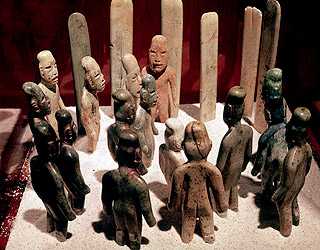  Three pre-Incan "nations or races" were determined through skull morphology by Dr. Tschudi (6). He names the Chinchas, Aymaraes, and Huancas. He suggested that Skulls of the Chinchas were what we would call normally human. The other two "races" were remarkably unlike the Chinchas. The Huancas had the most pronounced dolichocephalic traits. And it was this people about which Tschudi had the least amount of historical data. The Aymaraes "commenced the dynasty of the Incas." Of the Aymaraes, Tschudi said, "The crania of these people present differences equally remarkable ... and particularly the contour of the cranium." Keeping in mind that Inca is a term venerating the emperors of Peru, not a tribe/nation per sé - He proposed that the Aymaraes conquered the other two peoples and marshaled the unity of Inca civilization It is interesting to note that of the three "races" discussed, the non-dolicho-headed group, the Chinchas, artificially mimed the actual "conehead" peoples.
Friedrich Ratzel in 'The History of Mankind' reported in 1896 that deformation of the skull, both by flattening it behind and elongating it towards the vertex, was found in isolated instances in Tahiti, Samoa, Hawaii, and the Paumoto group and occurring most frequently on Mallicollo in the New Hebrides (today Malakula, Vanuatu), where the skull was squeezed extraordinarily flat. The practice was also known among the Australian Aborigines.
However, there is a fundamental difference between cranial deformation and other cultural forms of bodily mutilation (such as foot bandaging, genitalia deformation, scarring or tattooing), because the literature invariably concludes that such cranial deformation was intended to emulate either the look of the gods, the nobility, or to demonstrate social status. 'Even in the remote Nahai-speaking area of Tomman Island and the south south-western Malakulan (Australasia), a person with an elongated head is thought to be more intelligent, of higher status, and closer to the world of the spirits' (1). Hippocrates (from 400 BC) tells us that the practice among the Scythians was for the purpose of giving a certain aristocratic distinction. Amedée Thierry, in his “History of Attila,” says the Huns used it for the same reason; (2) 'The following heads.. (from Del Rio’s “Account of Palenque,” copied into Nott and Gliddon’s “Types of Mankind,” p. 440) ...show that the receding forehead was a natural characteristic of the ancient people of Central America. The same form of head has been found even in fossil skulls. We may therefore conclude that the skull-flattening, which we find to have been practised in both the Old and New Worlds, was an attempt of other races to imitate the form of skull of a people whose likenesses are found on the monuments of Egypt and of America. It has been shown that this peculiar form of the head was present even in the fœtus of the Peruvian mummies'. (2)
"The Maya elite practised changing the shape of
their offsprings' skulls to resemble the Maize God's elongated head by tying
two boards front and back against the infant's head"
Nature Vs Nurture:
'At first, usage was the
principal cause of the length of their head, but now nature cooperates with
usage'.
There are always cases of exception in the medical record, but of particular interest here is the fact that the volume of some of these skulls has been found to be twice that of a normal skull, and with it an increased brain capacity, which raises the obvious question: How is it possible for the skull and brain capacity to increase in a human unless it is caused by genotype, and what is the effect on the individual? 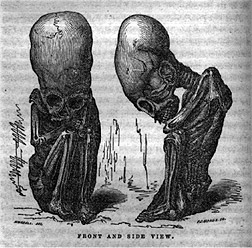 "More still: the same formation of the head presents itself in children yet unborn; and of this truth we have had convincing proof in sight of a foetus enclosed in the womb of a mummy of a pregnant woman, ... which is, at this moment, in our collection." The foetus was aged 7 months! (6) The records of the inspections of the Maltese skulls also suggest that there were elongated skulls present that weren't artificially modified, but were a natural feature (a genetic aberration, or an inherited one). The recognition that larger skulls also have a larger brain capacity certainly provides an impetus for such practices, but doesn't answer the question of who the original cone-heads were, or why they were emulated for so persistently around the ancient world. Sadly, these are questions that can only be answered through comparative DNA testing of elongated skulls around the world, something that has yet to be done. |
References:
1). http://en.wikipedia.org/wiki/Artificial_cranial_deformation 2). http://japanesemythology.wordpress.com/east-asian-native-american-hun-and-scythian-practices-artificial-deformation-of-the-skull/ 3). http://www.themedicalbag.com/bodymodstory/head-flattening 4). http://www.perceptions.couk.com/authority.html 5). http://www.clas.ufl.edu/users/nparr/index_files/Page398.htm 6). Mariano E. Rivero and John James Von Tschudi, M.D. Peruvian Antiquities. First published in 1851. 7). http://www.desertfoxoverland.co.uk/malta_-_dolichocephaloids.HTM 8). http://frontiers-of-anthropology.blogspot.co.uk/2011/04/more-on-coneheads.html 9). John Marshall. Mohenjo-daro and the Indus Civilisation. 1931. Asian Educational Services. 10). Anton Mifsud - C. Savona Ventura- Facets of Maltese Prehistory- Prehistoric society of Malta, 1999
Further Research: Shaping's, Imitations: Monstrous Skulls: www.perceptions.couk.com
From Ancient Wisdom @ http://www.ancient-wisdom.co.uk/cranialdeformation.htm
For more information about new views of evolution see http://nexusilluminati.blogspot.com/search/label/evolution
- See ‘Older Posts’ at the end of each section
YOU can help this unique
independent website survive and stay online from a small cabin in a remote
rainforest
Donate any amount and receive at least one New Illuminati eBook!
Please click in the
jar -
For further enlightening
information enter a word or phrase into the random synchronistic search box @ http://nexusilluminati.blogspot.com
And see
New Illuminati – http://nexusilluminati.blogspot.com
New Illuminati on Facebook - https://www.facebook.com/the.new.illuminati
New Illuminati Youtube Channel - http://www.youtube.com/user/newilluminati/feed
The Her(m)etic Hermit - http://hermetic.blog.com
The Prince of Centraxis - http://centraxis.blogspot.com (Be Aware! This link leads to implicate &
xplicit concepts & images!)
DISGRUNTLED SITE ADMINS PLEASE NOTE –
We provide a live link to your original material on your site - which
raises your ranking on search engines and helps spread your info further! This site
is published under Creative Commons Fair Use Copyright (unless an individual article
or other item is declared otherwise by copyright holder) – reproduction for non-profit
use is permitted & encouraged, if you give attribution to the work &
author - and please include a (preferably active) link to the original (along
with this or a similar notice).
Feel free
to make non-commercial hard (printed) or software copies or mirror sites - you
never know how long something will stay glued to the web – but remember
attribution! If you like what you see, please send a donation (no amount is too
small or too large) or leave a comment – and thanks for reading this far…
Live long
and prosper!
From the New
Illuminati – http://nexusilluminati.blogspot.com
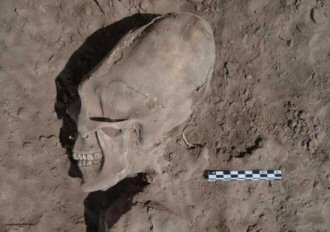
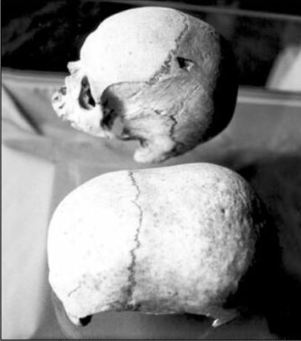
You explained the topic very well. The contents have provided meaningful information thanks for sharing info.
ReplyDeleteClick here to know more about Skull Turn Signals.